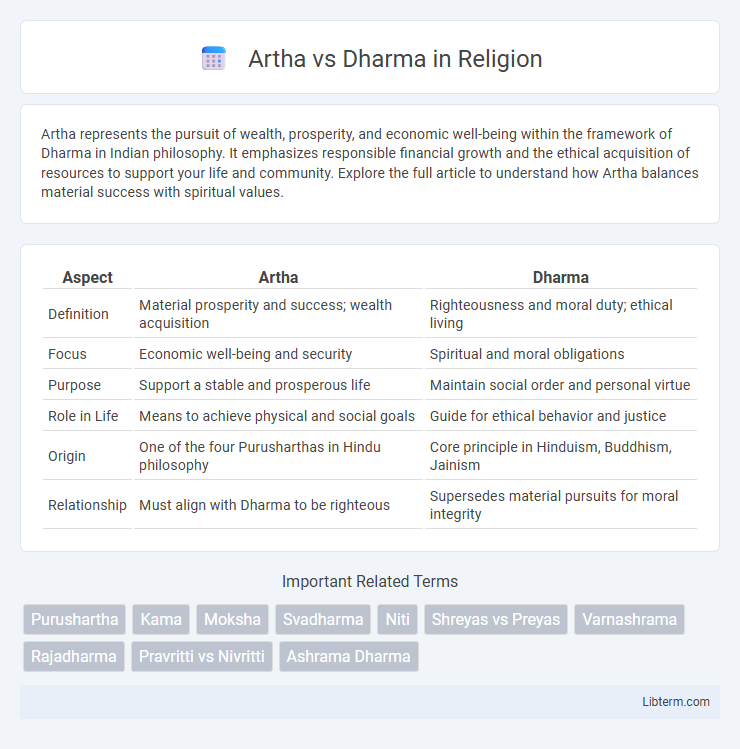Artha represents the pursuit of wealth, prosperity, and economic well-being within the framework of Dharma in Indian philosophy. It emphasizes responsible financial growth and the ethical acquisition of resources to support your life and community. Explore the full article to understand how Artha balances material success with spiritual values.
Table of Comparison
| Aspect | Artha | Dharma |
|---|---|---|
| Definition | Material prosperity and success; wealth acquisition | Righteousness and moral duty; ethical living |
| Focus | Economic well-being and security | Spiritual and moral obligations |
| Purpose | Support a stable and prosperous life | Maintain social order and personal virtue |
| Role in Life | Means to achieve physical and social goals | Guide for ethical behavior and justice |
| Origin | One of the four Purusharthas in Hindu philosophy | Core principle in Hinduism, Buddhism, Jainism |
| Relationship | Must align with Dharma to be righteous | Supersedes material pursuits for moral integrity |
Understanding Artha and Dharma: Foundational Concepts
Artha represents material prosperity and economic success essential for sustaining life and fulfilling desires, while Dharma embodies moral duty, righteousness, and ethical living that maintain societal order. Understanding Artha and Dharma involves balancing the pursuit of wealth with adherence to ethical principles, ensuring progress without compromising integrity. These foundational concepts guide individuals in harmonizing personal ambition with social responsibilities, forming a core aspect of Hindu philosophy.
Historical Context of Artha and Dharma in Indian Philosophy
Artha and Dharma have distinct historical contexts in Indian philosophy, where Artha primarily represents material prosperity, wealth, and economic goals essential for sustaining life, while Dharma signifies moral duties, ethical conduct, and social responsibilities guiding righteous living. Ancient Indian texts like the Arthashastra emphasize Artha as a practical necessity for governance and societal stability, whereas Dharma is rooted in Vedic scriptures, Upanishads, and epics, underscoring spiritual law and duty. The interplay of Artha and Dharma reflects a balanced approach in classical Indian thought, integrating material success with ethical principles to achieve holistic well-being.
The Role of Artha in Personal and Social Life
Artha, representing wealth, prosperity, and material success, plays a crucial role in personal and social life by providing the resources necessary for stability and growth. It enables individuals to fulfill their duties (dharma) and support family and community welfare, fostering social harmony. Pursuing Artha in accordance with ethical principles ensures balanced development without compromising moral values.
Dharma: Ethical and Moral Dimensions
Dharma encompasses the ethical and moral dimensions guiding human behavior, emphasizing duty, righteousness, and virtue in alignment with cosmic order. It establishes principles for justice, honesty, and compassion, ensuring social harmony and personal integrity. Unlike Artha, which focuses on material wealth and success, Dharma prioritizes moral responsibility and spiritual growth as essential components of a meaningful life.
Balancing Material Pursuits and Moral Duties
Artha emphasizes the pursuit of wealth, prosperity, and material success, essential for sustaining life and fulfilling social responsibilities. Dharma represents moral duties, ethical behavior, and spiritual obligations that guide individuals toward righteousness and societal harmony. Balancing Artha and Dharma ensures that material pursuits do not compromise ethical standards, promoting a holistic approach to personal and communal well-being.
Artha vs Dharma: Common Conflicts and Resolutions
Artha and Dharma often conflict when the pursuit of material wealth clashes with ethical duties and moral responsibilities, leading to dilemmas in decision-making. Common resolutions involve balancing pragmatic goals with righteous conduct by prioritizing actions that sustain long-term societal welfare and personal integrity. Integrating Artha's economic objectives with Dharma's ethical framework fosters harmonious outcomes that align prosperity with virtue.
Lessons from Ancient Texts: Artha and Dharma in the Mahabharata
The Mahabharata presents Artha as the pursuit of wealth and material prosperity essential for societal stability, while Dharma embodies moral duty and righteousness guiding ethical behavior. Lessons emphasize balancing Artha with Dharma to ensure prosperity does not compromise ethical values, promoting harmony in personal and societal life. This ancient text underlines that true success arises from fulfilling one's duties without forsaking moral principles.
Practical Applications in Modern Life
Artha, representing material wealth and economic prosperity, emphasizes practical strategies for financial planning, career growth, and resource management in modern life. Dharma focuses on ethical principles, guiding individuals to make morally sound decisions and maintain social harmony in personal and professional contexts. Balancing Artha and Dharma enables sustainable success by aligning financial goals with ethical responsibilities.
Cultural Influence on Artha and Dharma Interpretations
Artha and Dharma, foundational concepts in Indian philosophy, reflect distinct yet interrelated cultural values shaping societal norms and individual duties. Artha emphasizes material prosperity and economic well-being, deeply influenced by historical shifts in trade, governance, and social hierarchy, while Dharma embodies ethical guidelines and moral responsibilities, molded by religious doctrines and local traditions across regions. Variations in interpreting these principles demonstrate the dynamic interplay between cultural contexts and philosophical ideals, underscoring their role in guiding behavior and sustaining social order.
Achieving Harmony: Integrating Artha and Dharma
Achieving harmony between Artha and Dharma requires balancing material wealth with ethical responsibilities, ensuring success does not compromise moral values. Integrating Artha, the pursuit of prosperity, with Dharma, the adherence to righteousness, fosters sustainable growth and societal well-being. This synergy promotes a fulfilling life where economic goals align with spiritual and social duties, creating a holistic approach to personal and communal harmony.
Artha Infographic

 libterm.com
libterm.com